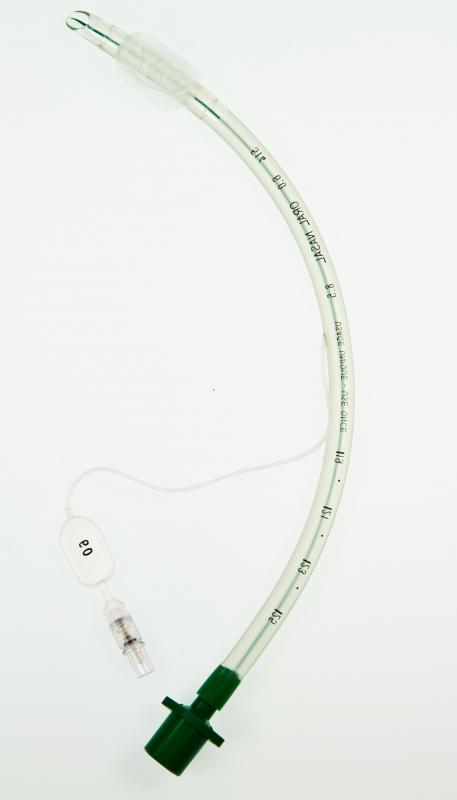At WiseGEEK, we're committed to delivering accurate, trustworthy information. Our expert-authored content is rigorously fact-checked and sourced from credible authorities. Discover how we uphold the highest standards in providing you with reliable knowledge.
What is Endotracheal Intubation?
Endotracheal intubation is placement of an endotracheal tube into the mouth or nose down to the airways to provide a person with breathing support. Intubation might occur for many reasons. It’s performed in different circumstances and could be a procedure that occurs when patients are deeply sedated, or might happen with or without local anesthetic when people are awake. Length of time a person remains intubated is based on varying, and occasionally unpredictable factors.
A doctor usually performs this procedure, first evaluating the vocal cords with a laryngoscope. Since endotracheal tubes come in sizes, the laryngoscope view and evaluation of factors like patient size and age help to determine which tube to use. Doctors don’t always pick the right tube at first, particularly if there is swelling in the vocal cords. Successful intubation occurs when the tube is threaded either from nose or mouth down past the cords, providing airway passage to the lungs. Mistakes can be made, and some inexperienced clinicians thread the tube into the esophagus instead, which needs to be remedied quickly.

After endotracheal intubation takes place, people may receive oxygen and ventilation via a machine, which can perform all breathing function. It’s also possible for people to breathe through the tube. When people undergo removal of the tube, they may be gradually weaned of the ventilator and take more breaths on their own, signifying extubation readiness.

A main reason endotracheal intubation is performed is to compensate for inadequate breathing. Someone injured or ill might require a breathing tube. This is also a preventative step for a variety of surgeries that require general anesthesia. After a person has been given sedating medications, intubation may be performed to support breathing during and possibly after the surgery.

With surgical endotracheal intubation, an important reason to intubate is to make certain people don’t vomit and inhale, or aspirate, this matter into the lungs. Aspirating greatly increases the risk for pneumonia. Another basis for endotracheal intubation is to support breathing while people are heavily sedated. Many anesthetics severely suppress breathing.

Rarely, endotracheal intubation takes place when people are conscious. More often people recovering from illness or injuries wake up with a breathing tube, which can be very scary. It’s not possible to talk, people may fight the ventilator and it can be a challenging experience. When fully awake, many people are quickly extubated, but those with serious medical conditions could be conscious for some time of the breathing tube in place. There’s a slippery slope in helping to promote patient comfort at this time. Giving sedatives to reduce awareness also suppresses breathing. Determining the best time to remove an endotracheal tube is nuanced and delicate, aimed at achieving extubation quickly without stressing the patient.

Endotracheal intubation has risks. Long-term ventilation may create dependence, rendering it difficult to achieve extubation. Trauma sometimes occurs to the vocal cords or larynx, affecting the voice after it, and some people develop infections from this procedure. These risks are likely to be outweighed by benefit and need for intubation.
AS FEATURED ON:
AS FEATURED ON:















Discuss this Article
Post your comments